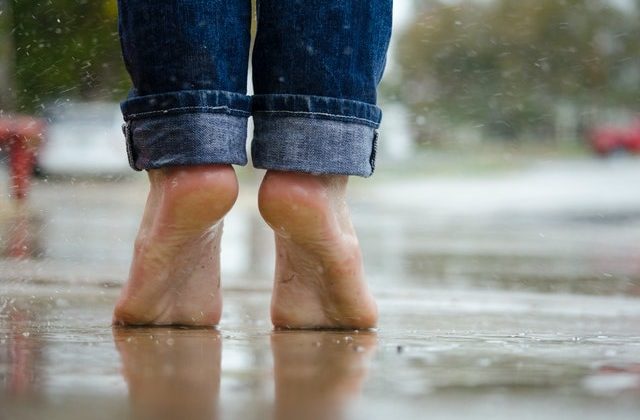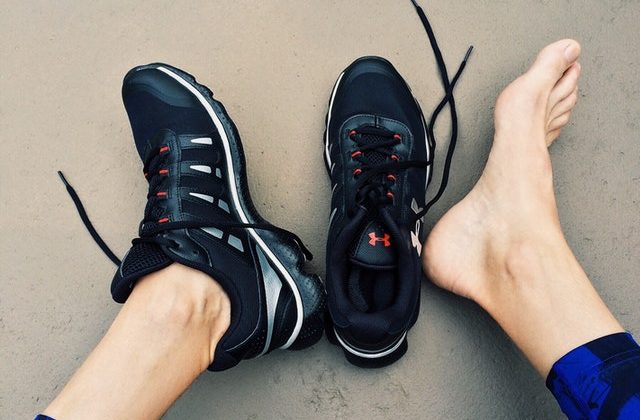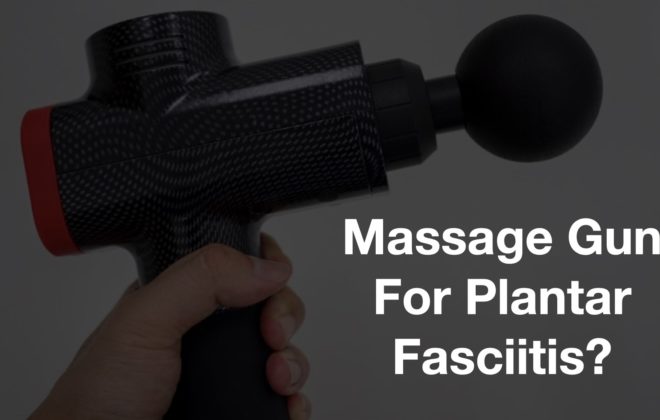Self Massage For Plantar Fasciitis – The Complete Guide
Plantar fasciitis is a particularly annoying problem due to the fact that it requires a multi-disciplinary approach to resolving it.
Self massage for plantar fasciitis is one component of an overall strategy for putting an end to chronic foot pain. Some of the other crucial factors to address include exercises and stretching.
In this post, we will cover how to perform self massage techniques for plantar fasciitis in the case you aren’t able to get professional assistance from a massage or physical therapist.
Self Massage For Plantar Fasciitis
General Principles Of Self Massage
While you don’t need to be a professional massage therapist in order to get some relief by improving blood flow via self-massage, there are some things you need to know in order to maximize results and reduce the chances of irritating your foot.
Most of the poor results that I have seen from massage therapy are related to not following simple rules and practices as you’ll find below.
Where To Massage
The Plantar Fascia Itself
The most common pain point for plantar fasciitis is located on the inside of the foot toward the heel. The red circle in the image above is where the most tender spot will usually be located, but some people will have a very sensitive spot more toward the big toe.
This does NOT mean its the only area to massage, in fact, I recommend avoiding any aggressive direct pressure on this spot. The most effective method for plantar fasciitis relief is to treat the tissues around the spot.
All the areas where the foot is taped are important areas to work.
Here is a video to explain how to work on the specific pain point carefully:
Calves
The calf muscles, located on the back of the lower leg, can have a profound influence on plantar fasciitis issues. There are a number of reasons for this, but they can be directly responsible for reduced dorsiflexion of the ankle.
Limited dorsiflexion is a predictor and common finding in plantar fasciitis. Trigger points in the calf muscles often refer sensation to the ankle and foot as well, so they may have a role in soft tissue dysfunction.
There are two muscles in the calf group including the gastrocnemius and soleus.
You don’t need to worry about targeting them separately with self-massage techniques. They lie on top of one another, so pressing straight down through the tissues will get both of them.
The easiest and most effective way to massage the calf muscles is with a foam roller.
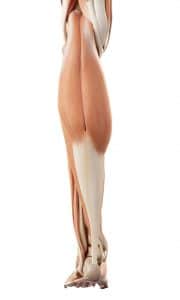
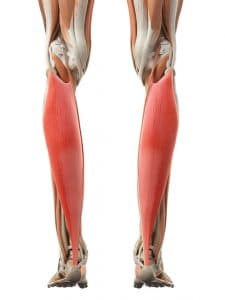
Heel
The heel is often tender and massaging this area can be very helpful. The standard massage tools, however, are not a great option for massaging this area. Generally, I like to use a compression or pinching-type technique by cupping the heel of my hand to squeeze the tissues.
This technique unfortunately can be challenging to perform because it requires some endurance in the muscles of the hand. I suggest performing it before adding any massage lubricant to the tissues in order to get a good grip.
You can also use a rubber jar opener to improve your ability to hold onto the tissue and prevent slippage.
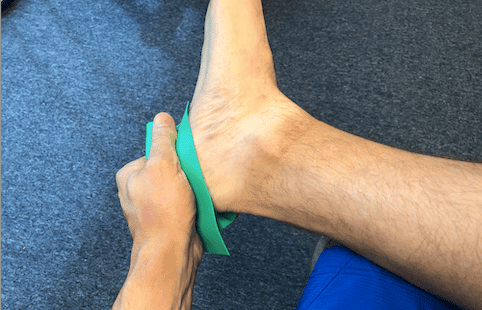
How Long Should You Massage?
Self-massage generally lasts 3-5 minutes per area, but this depends strongly on where you are working. On thinner tissues, as as the plantar fascia itself, that range is plenty.
When massaging thicker, more dense tissues like the calves, 5-10 minutes is a good time frame.
Intensity matters when considering the length of time you should spend on self massaging an area. As a general rule, the more intense, the less time.
How Much Pressure Should You Use?
It’s common to see videos of therapists on Youtube digging into people doing deep tissue massage while they squirm and grimace in pain, but this style of therapy is both excessive and in my opinion rarely productive. Many of these individuals seem to know very little about the condition or about how successful therapists are treating plantar fasciitis.
I’ve long been an advocate of using the least amount of pressure needed to create a therapeutic response. Many therapists use too much pressure because they believe they need to “break up scar tissue or adhesions”, which there is absolutely no evidence to support. Reducing the sensitivity of plantar fascia trigger points may be helpful, but not a whole lot of evidence backs this idea either. (Still worth trying).
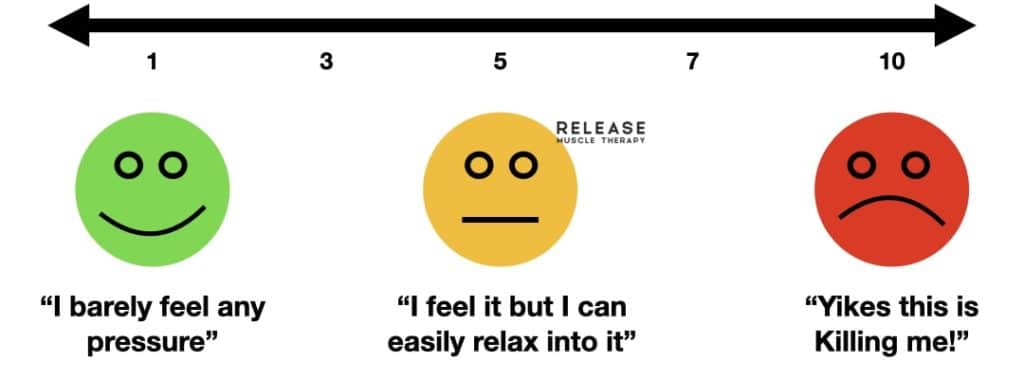
To put this into a simple scale reference on a 1 to 10:
1/10: You can feel contact on the tissue but nothing else.
10/10: You can’t take it you have to tell the therapist to stop.
A 5 is the max amount of pressure to be used. At this level of pressure, the experience would evoke the description “I can feel some discomfort and the pressure, but I can easily breathe and relax into it without much difficulty.”
Keep in mind I said a 5/10 is MAX. I recommend starting off with a 3/10 pressure to see what kind of response you get and if there is any tissue soreness the next day before adding any more pressure.
How Often Should You Self Massage Plantar Fascia?
Low-intensity self massage can be done daily as long as it does not provoke pain symptoms. Since there are many areas to work when dealing with plantar fasciitis, muscles groups can be rotated day-by-day to allow for recovery if needed.
Tools For Massaging The Foot
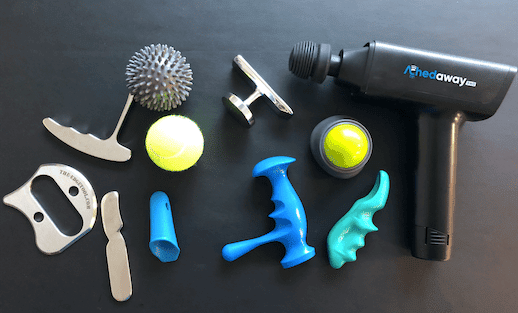
There is a huge variety of massage equipment and tools available for self massage that will work for the foot. Everyone has their favorites. There are a few things to consider when selecting a tool for self massage for plantar fasciitis.
Passive vs. Active
Some tools, like electric foot massagers, pressure mats, or a massage gun, do the work for you. Other tools, such as handheld pressure bars and so forth, require you to do the work.
Leverage
Since you’ll be working on the bottom of your foot, you will want to choose a tool that matches your level of flexibility (you need adequate hip and back flexibility to reach the bottom of your foot and hold it there while you work on it).
Some tools such as the trigger point cane are long and hook shaped which may be a better option for some people.
To cover all the available tools that one could use for plantar fasciitis therapy is near impossible in one post, so I will be covering many of them in upcoming posts here on the site.
Most people can simply start using a tennis ball, golf ball or small spiky massage ball to massage the bottom of the foot.
Self Massage Mats For Plantar Fasciitis
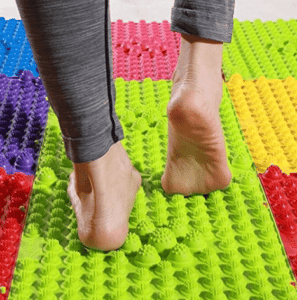
Foot massage mats are a fantastic way to introduce self massage for plantar fasciitis into a routine. They are super cheap, highly effective, and the amount of weight you place on them can be graduated.
One of the main benefits I like from these mats is the massive flood of sensory input into the tissues due to so many small contact points. The majority of my clients are amazed at how much better their foot feels after 3-5 minutes on one of these mats.
I always recommend starting out in the seated position, which minimizes the weight you’re placing on the mat. Even at this level, the sensitivity may be high for some people.
WARNING: It is important as mentioned previously to NOT put heavy pressure directly into the main pain point on the foot. In the mat shown in the video and above, there is a raised section in the middle of the mat that is particularly intense to put pressure on.
This section should never be stood on directly for individuals dealing with plantar fasciitis or any other foot issue without consulting your doctor for guidance. Always work AROUND the primary pain spot.
To progress, the supported version would increase the weight on the mat, but is still a half-way option between seated and standing.
The standing version allows full weight bearing on the pressure mat, so this one needs to be worked into over time.
Do Foot Massagers Work?
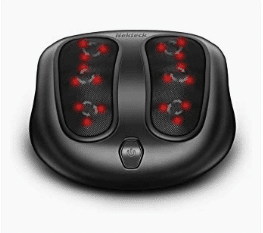
There are a variety of electric foot massagers available that, while generally feel good and can improve circulation, I don’t find them particularly helpful for plantar fasciitis massage.
This is mostly because the application of massage techniques on the bottom of the foot needs to be very specific, and as stated above, some caution about working specifically on the direct pain point on the heel.
These general devices at best will give you a general foot massage and not cause any issues, but at worst it can put too much pressure or emphasis on the primary pain area and trigger discomfort or a flare up that could take days to calm down again.
This isn’t worth in my opinion.
Now of course, if you find a good electric tool to massage your calves, then go for it, but don’t expect these tools to have the same results as doing self massage with a foam roller or a tool like the Double Up Roller.
Its worth mentioning that many people use a massage gun for plantar fasciitis. There is a good amount to know about this, which is why I covered the best massage gun for plantar fasciitis in another post.
Self Massage For Plantar Fasciitis Conclusion
Massage techniques can be immensely helpful for short-term relief of pain symptoms, but they absolutely need to be combined with an integrated approach in order to accomplish the overall goal of resolving plantar fasciitis.
Tags In
Sam Visnic
Most Popular Posts
Categories
- Deep Gluteal Pain Syndrome (8)
- Deltoids (2)
- Foam Rolling (2)
- Glutes (9)
- Hamstrings (5)
- Hypnosis for Pain (3)
- Lats (2)
- Levator Scapulae (4)
- Lifestyle (8)
- Massage Therapy (39)
- Mobility (21)
- Movement and Exercise (19)
- Muscles (22)
- Nutrition (2)
- Obliques (1)
- Pain (25)
- Pectorals (3)
- Piriformis (3)
- Plantar Fasciitis (11)
- Psoas (11)
- Quadratus Lumborum (3)
- Quadriceps (2)
- Rhomboids (3)
- Sciatica (1)
- Serratus Anterior (1)
- SI Joint (14)
- Sternocleidomastoid (1)
- Stretching (18)
- Subscapularis (1)
- TMJ (2)
- Trapezius (1)
- Uncategorized (12)


